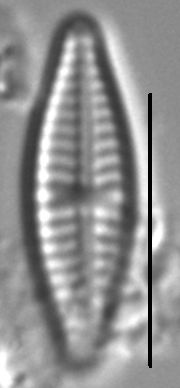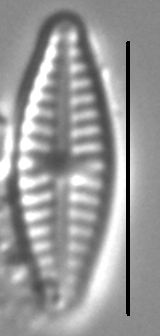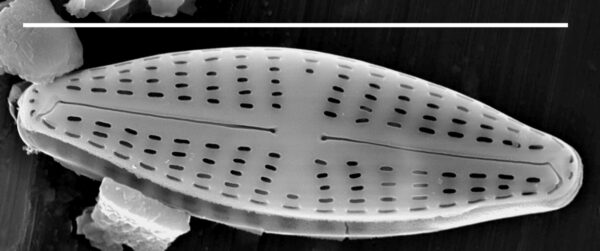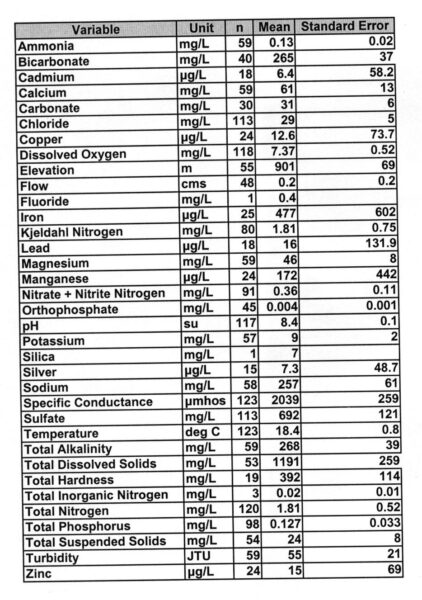Navicula goersii
-
Category
-
Length Range8-14 µm
-
Width Range3-4 µm
-
Striae in 10 µm14-18
-
Contributor
-
ReviewerRex Lowe - Oct 2011
Identification
Description
Frustules are flat, almost always coming to rest in valve view due to shallow mantles (1.5-2.0 µm deep). Valves are broadly lanceolate with acutely rounded ends in all but the smallest specimens. The axial area is narrow. Central area is broad, rectangular and reaches nearly to the valve margins. A single, shortened stria is present on each side. External raphe fissures are straight and threadlike. Proximal raphe ends are slightly inflated and relatively distant from one another. Terminal raphe fissures are bent diagonally toward the valve margin and are characteristically in close contact with a single areola at each apex, making the raphe fissures appear as hook-like terminations. Striae are broad, lineate, radiate and slightly curved about the central area. The striae extend onto the valve mantle. A crown of small areolae of different shapes are present at each valve apex. Striae are parallel or slightly convergent toward the valve apices.
Autecology
Most records of Navicula goersii are from streams in the semi-arid West and only a few are from the eastern United States. Navicula goersii prefers nutrient-rich alkaline waters with somewhat elevated conductance (see table below). These waters are typical of the sagebrush and grassland prairies of the western United States. Common diatom associates of N. goersii are Diploneis puella, Navicula caterva, Biremis circumtexta, Navicula canalis, Fallacia tenera, Nitzschia reversa, and Pleurosigma delicatulum.
-
Size Range, µm3
-
Motility
-
Attachment
-
Habitat
-
Occurrence
-
BCG
-
Waterbody
- Learn more about this
Original Description
Valvae late lanceolatae, apicibus angustatis usque ad rostellatos. Area axialis angustata. Area centralis latus, rectangularis, extensus fere ad marginem valvarum, unus abbreviatus stria in uterque latus. Raphe rectus, filiformis. Striae latae, lineolatae, radiatae et leviter curvae circa area centralis, parallelae vel leviter connivens ad apices, 14 (medium) ad 16 (apices) in 10 µm. Longitudo, 8-14 µm (typice 12 µm). Latitudo, 3-4 µm (typice 3.5 µm).
-
AuthorBahls 1983
-
Length Range8-14 µm
-
Width3-4 µm
-
Striae in 10µm14-16
Citations & Links
Links
-
North American Diatom Ecological DatabaseNADED ID: 93175
Cite This Page
Bahls, L., Morales, E., Potapova, M. (2011). Navicula goersii. In Diatoms of North America. Retrieved October 23, 2024, from https://diatoms.org/species/navicula_goersii
Responses
The 15 response plots show an environmental variable (x axis) against the relative abundance (y axis) of Navicula goersii from all the stream reaches where it was present. Note that the relative abundance scale is the same on each plot. Explanation of each environmental variable and units are as follows:
ELEVATION = stream reach elevation (meters)
STRAHLER = distribution plot of the Strahler Stream Order
SLOPE = stream reach gradient (degrees)
W1_HALL = an index that is a measure of streamside (riparian) human activity that ranges from 0 - 10, with a value of 0 indicating of minimal disturbance to a value of 10 indicating severe disturbance.
PHSTVL = pH measured in a sealed syringe sample (pH units)
log_COND = log concentration of specific conductivity (µS/cm)
log_PTL = log concentration of total phosphorus (µg/L)
log_NO3 = log concentration of nitrate (µeq/L)
log_DOC = log concentration of dissolved organic carbon (mg/L)
log_SIO2 = log concentration of silicon (mg/L)
log_NA = log concentration of sodium (µeq/L)
log_HCO3 = log concentration of the bicarbonate ion (µeq/L)
EMBED = percent of the stream substrate that is embedded by sand and fine sediment
log_TURBIDITY = log of turbidity, a measure of cloudiness of water, in nephelometric turbidity units (NTU).
DISTOT = an index of total human disturbance in the watershed that ranges from 1 - 100, with a value of 0 indicating of minimal disturbance to a value of 100 indicating severe disturbance.

Navicula goersii
- Valves small
- Single short stria on each side of central area
- Apices subrostrate
- Striae radiate, slightly curved about central area
Valves are small (< 20 µm) and broadly lanceolate, with acutely rounded apices. The central area is rectangular with a single, short stria on each side. The striae are slightly radiate and those near the central area are curved.
 Diatoms of North America
Diatoms of North America







